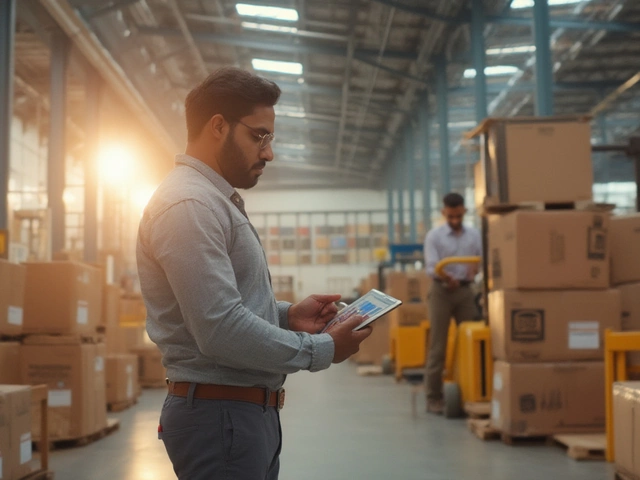So you’re eyeing the delivery boom and thinking, “Why not start from home?” You don’t need a big warehouse or even a business partner to get moving. All you really need is a reliable car, a smartphone, and a mindset that doesn’t mind running errands or braving traffic in all sorts of weather. Most folks actually start solo—often just using their family car and a small corner of their garage as a base.
Here’s a cool fact: During the 2020s, countless delivery businesses started out of living rooms and spare bedrooms. With e-commerce showing zero signs of slowing down, demand for local couriers has never been higher. Grocery drops, pharmacy runs, small moving jobs—people want it all, and they want it fast. That’s your shot.
But don’t worry about being outgunned by the giants like UPS or FedEx right now. Local delivery shines because you can be faster, friendlier, or handle those awkward requests big companies ignore. Before you do anything, jot down what your day-to-day might look like: Will you stick with groceries and prescriptions, or branch out into moving furniture or delivering flowers?
Keep things simple at the start. Handle the jobs you’re confident about, track every dollar coming in and out, and treat every delivery as a step toward repeat business. The key is starting with what you have—then building up as your reputation grows.
- What You Need to Set Up at Home
- Sorting Out Licenses and Insurance
- Finding Customers and Setting Rates
- Making It Sustainable and Profitable
What You Need to Set Up at Home
Kicking off a delivery business straight from your house is all about being smart with what you already have. Most people just need the basics: one clean, reliable vehicle (a used hatchback works fine), a smartphone that won’t quit on you midday, and a spot in your home to keep things organized—maybe a shelf in your garage or a free corner in your kitchen.
- Vehicle: Your car doesn’t need to be fancy, but keep it in solid working order. Most local courier services use compact cars since they grab less gas and are easier to park. If you’ll be handling big items, a van or truck helps, but most beginners get by with less.
- Smartphone and Data Plan: You’ll need reliable GPS, texting, and app access. Popular free apps like Google Maps, Waze, or RoadWarrior can save your hide when traffic goes rogue.
- Delivery Gear: Grab a few reusable totes or crates for groceries, and maybe some insulated bags if you’re handling anything that should stay hot or cold. If you plan to do bulk or heavier loads, a basic dolly or cart will protect your back.
- System for Tracking Orders and Payments: At the start, you can use Excel, Google Sheets, or even a spiral notebook to track deliveries. Payment apps like Venmo, PayPal, or Square let customers pay quickly and keep your cash flow visible.
- Insurance: Don’t skip this. Standard car insurance doesn’t always cover business use, so call your provider and ask about adding a business rider. It’s usually just a bit extra per month.
Here’s a quick look at what delivery startups use most often:
| Item | Purpose | Estimated Cost |
|---|---|---|
| Used car or small van | Primary transport | $5,000 - $12,000 (if purchased) |
| Smartphone + data | Navigation, communication | $50 - $100/month |
| Insulated bags/totes | Keep goods safe | $40 - $100 one-time |
| Basic insurance bump | Business protection | $30 - $60/month |
Even if you’re building this small business on a shoestring budget, don’t cut corners on safety or organization. Set up a basic system for wipes, hand sanitizer, and maybe a portable charger for your phone. You won’t regret it when you’re seven stops into your afternoon and someone texts, “Can you get this here in 30 minutes?” Being able to move quickly and keep things secure gets you repeat jobs faster than anything else in the courier services world.
Sorting Out Licenses and Insurance
If you want to run a legit delivery business from your home, paperwork is the first speed bump. Skipping this stuff can get your gig shut down before you even drop off your first package.
Start with your local city or county. Most places in the US ask for a basic business license, sometimes called a "business tax receipt." Usually, this is about $50 to $100 per year, and they just want to know who’s running businesses in their area. In some states, if you trade under a name other than your own, you’ll need a "Doing Business As" (DBA) registration. Check your state government’s small business portal—it’ll spell out what you need, step by step, usually in a few clicks.
If you deliver stuff in your personal car, don’t assume your regular car insurance has you covered. Most personal car policies shut down claims the moment you admit you’re delivering for money. That’s where commercial auto insurance comes in. This isn’t just legal box-ticking—if you ding someone’s car or get rear-ended while making deliveries, commercial insurance keeps your finances safe. Here’s a quick look at the difference:
| Personal Car Insurance | Commercial Auto Insurance |
|---|---|
| For personal driving only | Covers business use, including delivery |
| Often denies delivery claims | Protects against accidents on the job |
| Cheaper, but risky for business use | Costs more, but keeps you legal and safe |
You’ll also want general liability insurance. This one protects you if a package gets damaged or lost, or if you accidentally track mud through a client’s house during a delivery. Policies often start around $30 to $50 a month from small business insurers or online platforms made for gig-economy workers. Some customers won’t even hire you unless you have it, especially businesses and clinics.
Want to keep everything straight? Make a checklist:
- Register your delivery business with local authorities (business license, DBA if needed)
- Get a tax ID number if you’re planning to hire anyone down the road
- Shop around for commercial auto and liability insurance—don’t just stick with your old provider
- Keep digital or paper copies of every form and insurance card in your car
Tackle this stuff before chasing customers. It pays off big time if something goes sideways during a busy week.

Finding Customers and Setting Rates
Getting those first few delivery business clients is way more about hustle and people skills than flashy ads. Start local. Go visit small shops, bakeries, florists, and local pharmacies. These people already want fast, flexible delivery—big companies usually don’t prioritize one-off local runs. Knock on doors, introduce yourself, and offer your services face-to-face. You’d be surprised how many shop owners just need someone reliable they can call or text.
Don’t forget about Facebook groups and neighborhood apps like Nextdoor. Drop a short post about your new courier services, mention your rates and areas you cover. Your neighbors are more likely to trust someone who lives nearby, so highlight that you’re local and motivated. Word-of-mouth is gold: after a few solid deliveries, ask happy customers to leave reviews on Google or recommend you to friends. It makes a huge difference.
Now, about those rates. There’s no magic formula, but you can’t just guess. Check how much the bigger delivery apps charge (like DoorDash or Postmates) for similar distances, and come in a bit lower at the start to get those early gigs. Here’s a quick comparison so you don’t have to look it up:
| Courier App | Base Delivery Fee | Extra Per Mile |
|---|---|---|
| DoorDash | $2.99–$5.99 | $1–$2 |
| Postmates | $3.99–$5.99 | $1–$2 |
| You (New Local) | $2.50–$4.50 | $1–$1.50 |
If you’re just starting, flat rates work best. For example: $7 for up to 3 miles, then $1.25 for each extra mile. But always factor in gas, tolls, and your time. The last thing you want is to end up making less than minimum wage after expenses.
One sharp tip: Offer package deals for regular clients, like local stores or pharmacies. Example: "5 deliveries per week for a set price." This makes your income steadier and makes life easier for businesses that want reliable small business delivery. Remind them—your direct contact and flexibility beats the generic help line of a big delivery company.
At the end of the day, you’re selling trust and speed, not just transportation. Keep your phone charged, reply fast, and remember every delivery is a chance to score another loyal customer.
Making It Sustainable and Profitable
If you want your delivery business to last and actually put cash in your pocket, you need more than just hustle. Let’s break down what keeps things rolling month after month—and why some folks fizzle out after a busy launch.
First off, keep a close eye on your money. Use an app or a simple spreadsheet to track expenses like gas, car maintenance, and even coffee runs you make between stops. It’s easy to forget the small stuff, but they add up fast. Aim for a profit margin of at least 20%—that’s the sweet spot a lot of experienced courier services shoot for, according to real small business surveys.
Your car is basically your office, so treat it right. Regular oil changes, rotating your tires, and checking your brakes could save you hundreds (or thousands) in repairs down the line. If your wheels break down, so do your earnings.
Set your delivery rates smartly. Don’t just copy what the big guys charge—calculate your rates based on your actual costs, plus a fair fee for your time. Try this quick formula:
- Add up your total weekly expenses for driving (gas, wear and tear, maintenance).
- Estimate how many deliveries you’ll do that week.
- Divide expenses by deliveries, then tack on your hourly rate.
Want to know what eats up most of your cash? Check the table below for typical breakdowns small delivery businesses see during their first year:
| Expense | Estimated % of Revenue |
|---|---|
| Fuel | 25% |
| Vehicle Maintenance | 10% |
| Insurance | 8% |
| Marketing | 6% |
| Other (phone, supplies, etc.) | 6% |
To really make your home-based delivery business work, focus on customers who order often—think small offices, local shops, and folks who can refer you around town. People love reliability, so texting customers when you’re on your way or using a simple tracking app can set you apart from the pack.
And don’t forget about side gigs. Many small courier services fill in slow days by partnering with local restaurants or signing up for overflow work with bigger companies. This keeps your income steady and helps you snag more business as you grow.
Keep asking yourself: Are you staying efficient? Is every trip worth the time and gas? When you spot room to do it better, tweak things fast. That’s how you build a business that lasts—and actually pays the bills.





